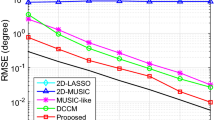Abstract
This paper deals with joint direction of departure (DOD) and direction of arrival (DOA) estimation using a subspace-based approach in bistatic multiple-input multiple-output radars. First, a conventional rotational invariance technique is used to estimate DOD. Then the steering vector of DOA corresponding to the estimated DOD is obtained using the proposed signal subspace estimation method. The steering vector is then converted to the angle of arrival. This way, the DOD and DOA pairing are automatically obtained. Numerical simulations show that the estimated angles using the proposed approach are more accurate than those using the conventional methods.





Similar content being viewed by others
References
Fishler, E., Haimovich, A., Blum, R., Chizhik, D., Cimini, L., & Valenzuela, R. (2004). MIMO radar: An idea whose time has come. In Proceedings of the IEEE radar conference (pp. 71–78), Newark, NJ, USA.
Fishler, E., Haimovich, A., Blum, R., Cimini, L., Chizhik, D., & Valenzuela, R. (2006). Spatial diversity in radars-models and detection performance. IEEE Transactions on Signal Processing, 54(3), 823–838.
Bekkerman, I., & Tabrikian, J. (2006). Target detection and localization using MIMO radars and sonars. IEEE Transactions on Signal Processing, 54(10), 3873–3883.
Li, J., & Stoica, P. (2009). Array signal processing for MIMO radar. UK: Wiley.
Yan, H. D., Li, J., & Liao, G. S. (2008). Multitarget identification and localization using bistatic MIMO radar systems. EURASIP Journal on Advances in Signal Processing, 1–8.
Xi, R., Liu, Z., & Wu, J. X. (2012). Direction finding with automatic pairing for bistatic MIMO radar. Signal Processing, 92(1), 198–203.
Zhang, X. F., Xu, L. Y., Xu, L., & Xu, D. Z. (2010). DOD and DOA estimation in MIMO radar with reduced-dimension MUSIC. IEEE Commuication Letters, 14(12), 1161–1163.
Tabrikian, J., & Bekkerman, I. (2005). Transmission diversity smoothing for multi-target localization. In Proceedings of the IEEE ICASSP (pp. 1041–1044), Philadelphia, PA, USA.
Duofang, C., Baixiao, C., & Guodong, Q. (2010). Angle estimation using ESPRIT in MIMO radar. Electronics Letters, 46(25), 770–771.
Zhang, X., & Xu, D. (1997). Low-complexity ESPRIT-based DOA estimation for colocated MIMO radar using reduced-dimensional transformation. Electronics Letters, 47(4), 283–284.
Bencheikh, M. L., Wang, Y., & He, H. (2010). Polynomial root finding technique for joint DOA DOD estimation in bistatic MIMO radar. Signal Processing, 90(9), 2723–2730.
Yang, M. L., Chen, B. X., & Yang, X. Y. (2008). Conjugate ESPRIT algorithm for bistatic MIMO radar. Electronics Letters, 44(12), 1692–1694.
Shi, W. T., Huang, J. G., & He, C. B. (2011). 2D angle and Doppler frequency estimation in MIMO radar. In Proceedings of the WCECS, San Francisco, USA, I.
Zhang, J. Y., Ma, P., & Liu, C. S. (2009). Angle estimation with automatic pairing for bistatic MIMO radar. In 2nd International congress on image and signal processing.
Jin, M., Liao, G., & Li, J. (2009). Joint DOD and DOA estimation for bistatic MIMO radar. Signal Processing, 89, 244–251.
Lee, C. C., & Lee, J. H. (1997). Eigenspace-based adaptive array beamforming with robust capabilities. IEEE Transactions on Antennas and Propagation, 45(12), 1711–1716.
Golub, G., & Loan, C. V. (1996). Matrix computations (3rd ed.). Baltimore, MD: Johns Hopkins University Press.
Hsieh, H. T., & Wu, W. R. (2011). Blind maximum-likelihood carrier-frequency-offset estimation for interleaved OFDMA uplink systems. IEEE Transactions on Vehicular Technology, 60(1), 160–173.
Acknowledgments
The authors would like to thank the anonymous reviewers for their valuable and constructive comments, which helped to improve the presentation of the paper. This work is partially supported by the National Science Council of Taiwan under grant no. NSC 102-2221- E-011-093 and NSC 102-2623- E-155-002.
Author information
Authors and Affiliations
Corresponding author
Rights and permissions
About this article
Cite this article
Hsu, CH., Liu, HC. & Hua, MC. Joint DOD–DOA Estimation Based on Signal Subspace Approach in MIMO Radars. Wireless Pers Commun 77, 951–961 (2014). https://doi.org/10.1007/s11277-013-1545-6
Published:
Issue Date:
DOI: https://doi.org/10.1007/s11277-013-1545-6




